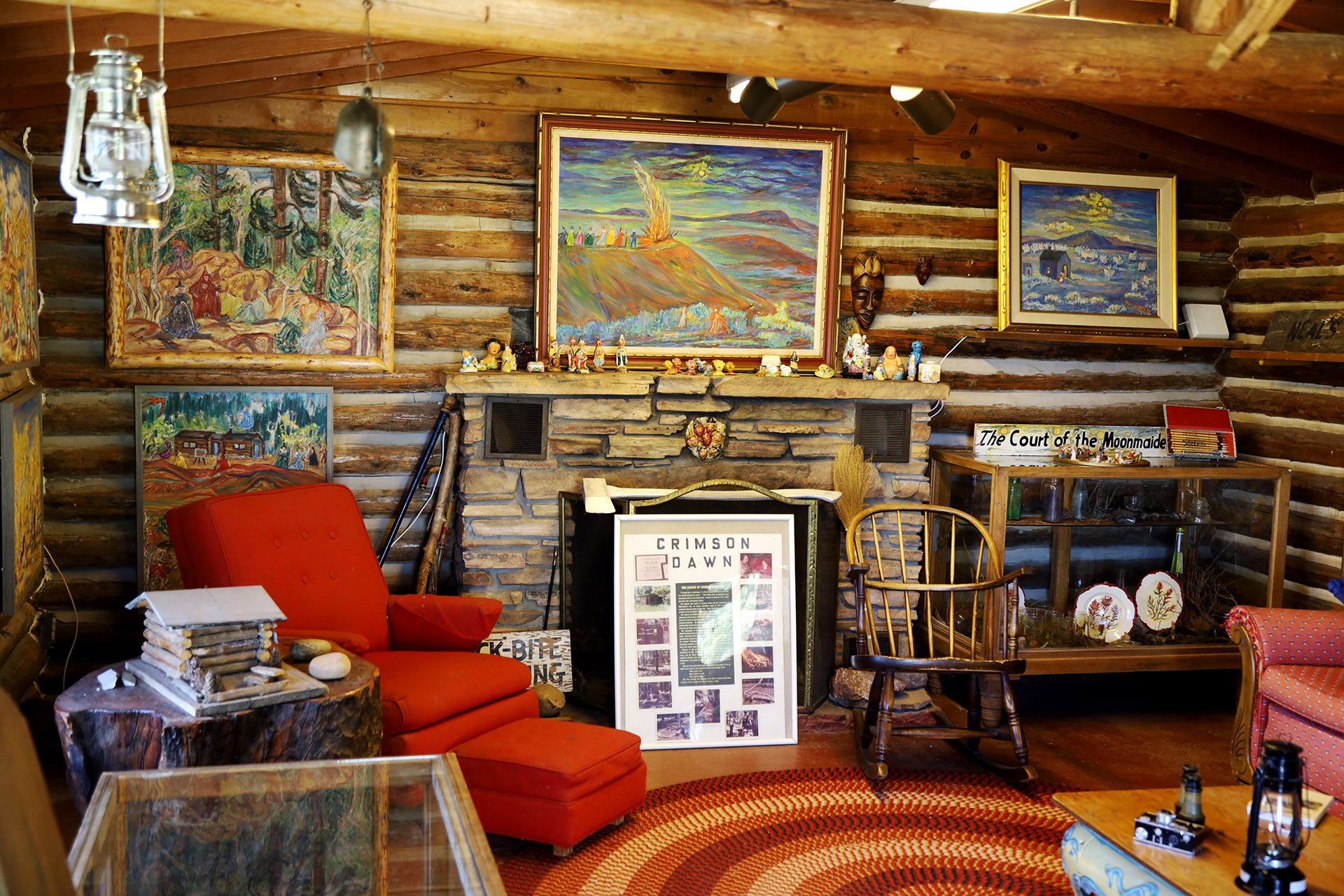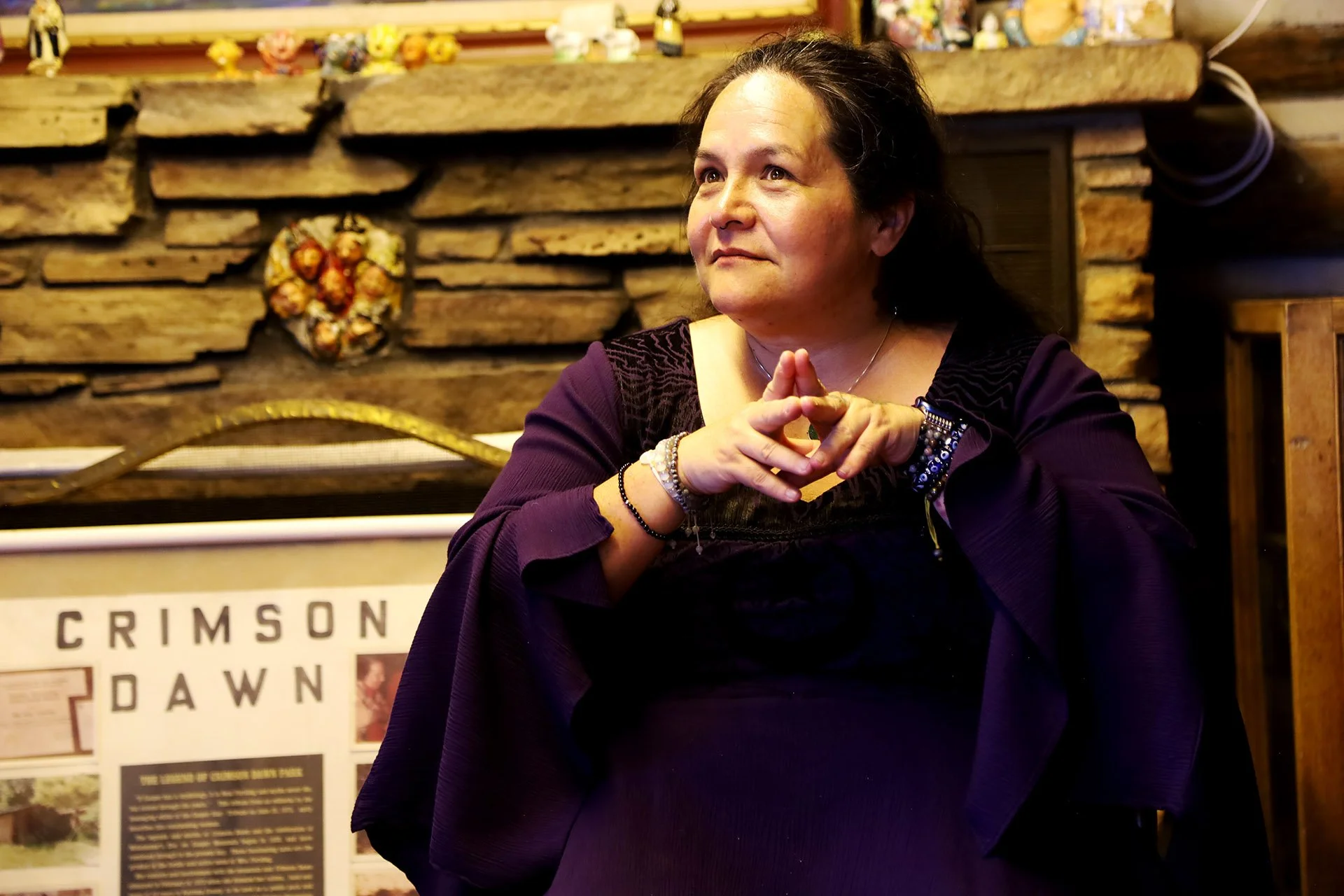Caretaking Inheritance
Gifted by Michele Lipes
Gathered by Nancy Small
Casper, June 2025
Michele recalls how she became the head caretaker of Neal Forsling’s cabin at Crimson Dawn. Caretaking is a meaningful inheritance for Michele, and she fondly recalls the role the mountain has played at the various ages and stages of her life.
Michele in Neal’s cabin at the Crimson Dawn 2025 festival. Photo by Aubrey Edwards.
Michele: I started coming up here when I was a Brownie. I was at Girl Scout Camp, and we came over to tour [Neal Forsling’s cabin]. Mary, Neal’s daughter, was active in the Girl Scouts and she took us out on the trails and told us the stories, kind of like how Neal did. And I fell in love with the place. I just fell in love at first sight. Eleanor, who was the first caretaker up here, came [and] she showed us pictures of the Midsummers event and told us stories and gave us cookies. Then, we sat and told stories around outside and it was a wonderful experience, and I fell in love then.
As a teenager, I would go camping with my friends over at Bear Trap and then I would ditch them and walk here and come and stay in the park on the Butte. Sneak in, you know, little things like that [that] teenagers do… fall asleep under the stars on the Butte. I fell in love with [this] place…then, I drifted off… work… life and then [I] started bringing my children up here and, you know, I'd never brought [them] into the museum because they were toddlers and [I] don't want them touching things and that sort of thing.
So, I was teaching them how to care for the land and pick up trash and that sort of thing. The caretaker at the time, Susan, had helped Eleanor. She approached me and asked me to be her helper. I did that for a while and then [I] ended up taking… my daughter was a fiddle player at the time…and [I] did the fiddle competition tour with my daughter. Unfortunately, Susan got sick and passed away and the county asked me to take over and be the head caretaker up here. It was sad…Susan at the time was ill and I was like, she needs to be up here as much as possible, I want her to have her weekends up here. That was how I ended up in the role… it [was] just like a tap on a shoulder. “I'm passing the torch onto you.” That sort of thing.
Nancy: It feels like it carries on a family tradition that started in that bedroom right there, with Neal. Through her daughters, then also through these kinds of, sisterly, familial relationships that grow out of [this] place. Is that a fair [statement]?
Michele: That is. It seemed like it was a very feminine role. Just passing on the torch [in] that way. And, you know, Neal passing it on to Mary and Mary telling the stories…and Eleanor…she was the youngest child that lived on the mountain at the time, and she felt [that] she was a painter and artist and the stories that she would tell! It’s my hope to be that passionate about it and tell the stories like she did. I've been doing [this] in some capacity [for] 20 years and my children are out running the gopher stuff for me. Right now. They're setting up a canopy for the sales of books. That sort of thing.
I was born and raised in Casper, and I lived briefly in Nevada when my family moved. I was a minor at the time, but I've always said that this is my home. I'm never leaving Wyoming, and if I do, it's probably to Alaska or to Greece or something like that. In the United States, Wyoming is so beautiful and so vast. There are so many different things to see. There’s just something about Wyoming that is home.
Nancy: How does the land or the space connect to your feelings of identity?
Michele: This is a funny one. I like the hot, dry weather and the cold, dry weather. The humidity is not my friend. Being native, my tribe is located here in Wyoming too. So, there's that cultural connection too.
Nancy: Do you remember any stories of that time and just learning to be in this space in a certain kind of relationship? Do you have any memories of that?
Michele: It was going in picking the wildflowers and learning how to photograph and develop those photographs in a dark room. It was the stories that we would tell around the campfire about bears and mountain lions and learning how to respect the animal life up here and to stay away from [the] animals and [giving] them their space and those sorts of things. Through stories. It was amazing…the learning of the lessons through a fun activity, within a story. That's with Neal's stories: there were little tidbits of lessons in them.
Note: The transcript above has been condensed from its original audio recording to improve the flow and readability of the story.
Below, Neal’s cabin. Photo by Aubrey Edwards.


